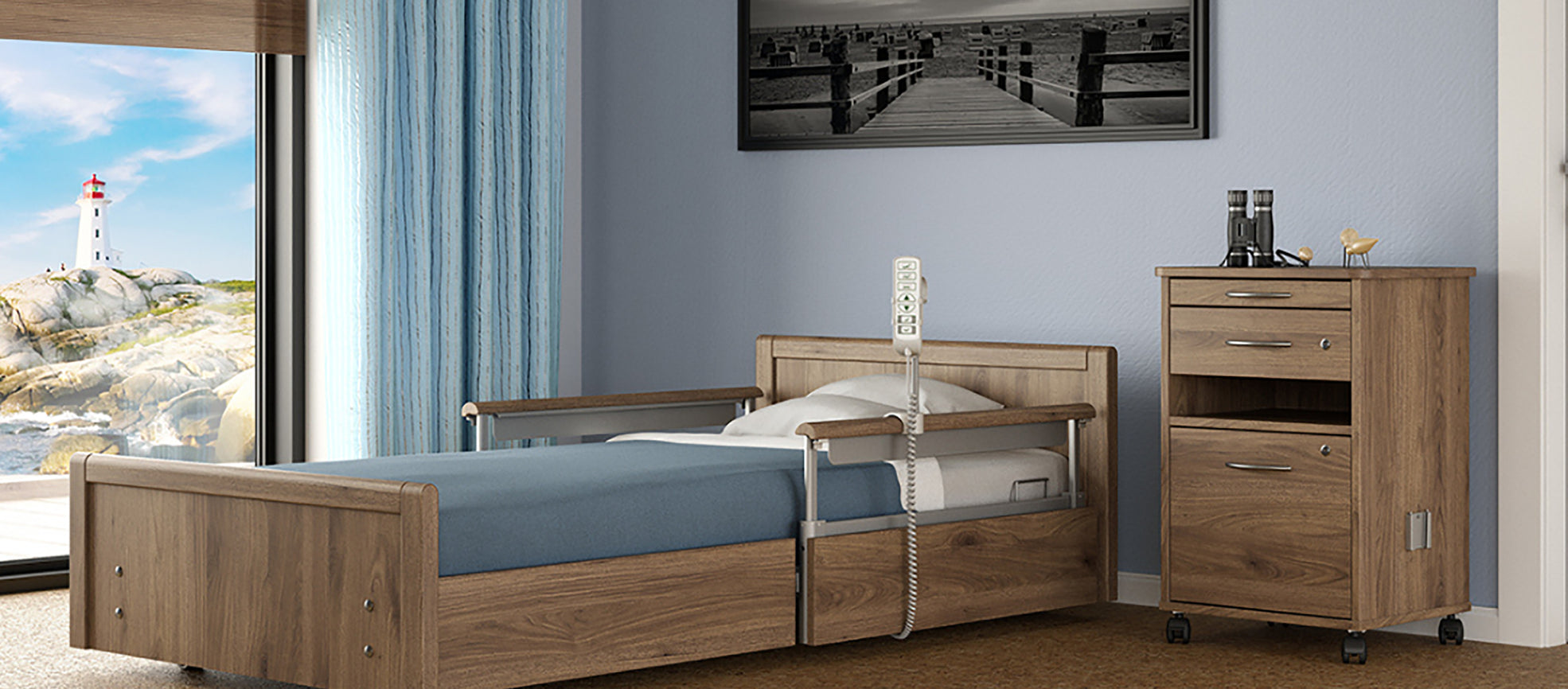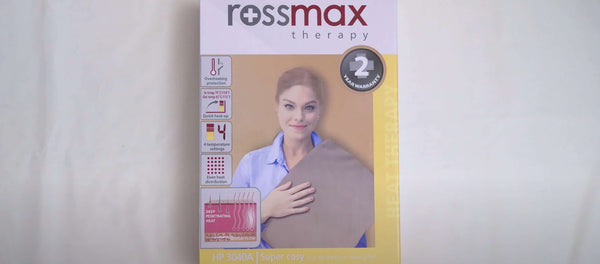A guide to buying a homecare bed or nursing hospital bed
Acquiring a suitable homecare bed can be a daunting task. Unlike smaller medical equipment like wheelchairs, homecare beds are bulky, heavy, and carry a significantly higher price tag.
Besides these apparent concerns, the stakes are high on getting the right bed. The complexity of the product and its technicalities can overload you, making it difficult to decipher which features are truly essential.
A good homecare or hospital nursing bed offers many benefits but there are also potential downsides and here’s why this blog can be helpful for you to make the right decision.
By carefully considering all options, you can make an informed decision and choose the best bed that provides comfort, safety, and support for your loved one.
What do you need to consider when choosing a Homecare Bed or Hospital Bed
Finding the perfect bed, whether for hospital recovery or long-term homecare, is crucial for a patient's well-being. Let's delve into the various aspects you need to consider to make an informed decision.
1. Medical Requirement
Based on the patient's medical needs, it is crucial to assess the specific needs of the individual who will be using the bed. This includes mobility limitations, pressure sore risk, respiratory conditions, and any other medical concerns. By understanding the patient's needs, you can choose a bed with features that directly address them.
Let’s explore certain medical conditions that can benefit from specific bed features.
Positioning for Comfort and Relief
Adjustable beds promote pain relief by allowing users to find comfortable positions. Raising the head of the bed can also ease breathing difficulties for those who experience sleep apnea or other respiratory issues.
Pressure Relief
Users on extended bed rest are at risk of developing bed sores, a bed with a specialized pressure relief mattress or overlay is essential.
Weight Capacity
A bed with a sufficient weight capacity is crucial for a plus-size patient or those requiring specialised equipment.
Length of Side Rails
Some dementia patients require full length side rails to prevent them from getting off the bed.
If you are unfamiliar with the specific medical needs of the user. Consult a doctor or a therapist to determine the features like pressure relief or positioning so as to optimise comfort and prevent complications.

2. Room Size
At Bion, we frequently encounter situations where customers' homes don't have enough space to accommodate their chosen homecare beds. In some cases, the bed's size might also present challenges when transporting it into the house. Therefore, it's important to ensure that there is adequate space for the bed itself.
Space is also essential for caregivers to safely assist with the user's transfers, getting in and out of bed, and providing routine care. Ample space not only allows caregivers to move freely but also empowers users to perform daily activities more easily. This, in turn, fosters a sense of calm and well-being in a spacious environment.
Here are some tips on how you can estimate if your room is big enough for a homecare or hospital bed.
Measure the bed
Start by looking at the manufacturer's specifications for the specific bed model you are considering. These specifications should include the bed's length, width, and height
Measure the room
Measure the available floor space in the room where you plan to place the bed. This should account for permanent furniture, doorways, and windows.
Visualisation
Measure the available floor space in the room where you plan to place the bed. This should account for permanent furniture, doorways, and windows.
Do keep in mind that it is always better to err on the side of caution and choose a bed that offers enough space for safe and comfortable use.

3. Caregiver or Care Worker Needs
Caregivers and care workers play a huge role in choosing the right bed, as caregivers often assist patients with getting in and out of bed, repositioning them, and providing daily care.
Demanding work (frequent lifting, awkward postures) leads to back pain and musculoskeletal disorders in many care workers.
Recognising the challenges faced by caregivers, homecare bed companies such as Wissner Bosserhoff have developed their beds to cater to the specific needs of care workers.
An example would be Wisser Bosserhoff’s Sentida SC. The homecare bed offers an optical care position of 80cm for back-friendly work, allowing care workers to carry out nursing routines that are easy for the back.
The Sentida SC nursing bed also has an undercarriage of 15cm which allows ergonomic and comfortable work with care aids. When caregivers can perform their duties efficiently and safely, it reduces stress and allows them to focus on providing emotional support to the patient. This can contribute to a more positive and healing environment for everyone involved.

4. Adjustable Features
Homecare beds and hospital beds come with a variety of features that cater to different needs and preferences.
You can ensure the user receives optimal comfort and support by evaluating the bed’s adjustable features. Adjustable features, such as height adjustment, allow patients to get in and out of bed easier and promote independence, while backrest and leg positioning options promote relaxation and pain relief.
5. Comfort
The ideal amount of time spent in a hospital bed can vary depending on the patient's specific condition and recovery needs. While initially providing much-needed rest, extended periods in a hospital bed can lead to trade-offs such as increased risk of pressure ulcers, muscle weakness, and blood clots can all emerge, ultimately hindering a patient's recovery. It is therefore crucial to look into the different attributes that will affect the patient's safety and comfort.
Weight Capacity
Exceeding the weight capacity of a bed can put undue stress on the frame and mechanisms, increasing the risk of breakdown and potential injury during use.
Mattress Type
Appropriate mattress selection are additional factors to consider when choosing the perfect bed. For heavier individuals, pressure relief becomes even more crucial to prevent pressure ulcers (bed sores) from developing. Mattresses like memory foam or alternating pressure mattresses excel at distributing pressure evenly.
An example of a pressure relief mattress would be Bion Anti-Bedsore Mattress V450. It pumps air in an alternating fashion which is great for patients who stay in bed for an extended period of time, or suffering from stage 1 & 2 pressure sore.

6. Safety
Safety features like side rails, grab bars and locking mechanisms, ensure user safety during transfers and reduces fall risk.
Side Rails
Side rails act as physical barriers, preventing accidental falls out of bed, especially during sleep or moments of disorientation. They're particularly important for individuals with limited mobility, balance issues, or those prone to confusion.

Grab Bars
Grab bars provide additional support and stability during transfers. They allow users to grip the bar for leverage when getting in and out of bed, minimising the risk of slipping or losing balance.
Locking Mechanism
Locking mechanisms prevent accidental adjustments during transfers or while the bed is occupied. This reduces the risk of the bed unexpectedly moving or lowering, potentially causing falls or injuries. Some locking mechanisms might be on the bed itself for height adjustments, while others might be on the wheels to prevent the bed from rolling unintentionally.
Homecare Bed VS Hospital Bed
While both homecare and hospital beds offer a comfortable and safe resting environment for individuals needing extended bed rest due to illness, injury, or age-related conditions, their purposes diverge.
Here are the key differences.
|
|
|
|
|
Primary Use |
Hospital setting |
Home environment |
|
Period Use |
Short-term recovery |
Long-term care needs |
|
Key Features |
Adjustability, support, IV pole compatibility for critical needs |
Adjustability, safety features (grab bars), comfort |
|
Benefits |
Promotes healing, prevents bed sores |
Improves lifestyle, independence, facilitates caregiving, facilitate proper positioning for sleeping, resting, or performing daily activities |
|
Aesthetics |
Medical vibes with metal and plastic |
Homey vibes with wood |
|
Usability |
More complex controllers with multiple buttons which require training |
Simpler controls, often featuring a handheld remote for easy adjustments |

Bion Homecare Beds VS Sentida SC Nursing Beds
When it comes to homecare beds, there is a surprising wide variety to choose from. You can opt for basic manual beds with adjustable headrests, or step up to electric models that let you modify both the head and foot incline with the push of a button. Some even offer advanced features like ultra-low positioning to prevent falls, or comfort seating position and prophylaxis position which promote the well-being of immobile patients.
The vast selection of homecare bed brands and models with many features can make choosing the right one a challenge. Here is a simple comparative chart of the Bion Homecare Bed and wissner-bosserhoff sentida sc Ts Nursing Bed.
|
|
|
|
|
Automatic positioning |
Yes. |
Yes. |
|
Height Adjustments |
Yes. |
Yes. |
|
Low Positions |
Lowest at 43cm. |
Lowest at 23cm. |
|
Head Section & Foot Section Adjustable |
Yes. |
Yes. |
|
Double Retraction |
No. |
Yes. |
|
Comfort Seating |
No. |
Yes. |
|
Prophylaxis Positioning |
No. |
Yes. |
|
Side Rails |
Yes, partial side rails. |
Yes, full side rails. |
|
Customisation |
No. |
Yes. |
What is double retraction
The double retraction mechanism offers a range of benefits for sitting comfort. By expanding the surface area of the backrest and thighrest, it optimises support throughout the entire seating area. This increased contact area translates to reduced pressure on sensitive areas like the buttocks and tailbone. Furthermore, the double retraction encourages a relaxed posture in the chest and abdomen by creating more space, which facilitates easier breathing. Finally, when combined with the chair's long, nearly 90 cm backrest, the double retraction function provides a comfortable and preventive positioning solution for residents with limited mobility.

What is Automatic Comfort Seating
The automatic comfort seating function allows patients to comfortably watch television, read, or enjoy breakfast in bed, contributing to a better overall quality of life.

What is prophylaxis position
The prophylaxis position is a featured designed to support caregivers in helping patients to prevent pressure ulcers and managing existing wounds. By frequently changing a patient's position, it helps to redistribute the pressure from prominent areas such as the heels and tailbone and it allows blood flow to return to these areas, preventing tissue damage.

What is low position
Low bed position can be beneficial for elderly and recovering patients in several ways. A lower bed makes it easier for patients to get in and out of bed independently. This reduces the risk of falls and injuries, especially for those with weakness, balance issues, or limited mobility.
Low bed position could also provide a sense of security as it reduces the fear of falling. The ability to get in and out of bed independently can boost a patient's morale and sense of self-efficacy. This positive mindset can support progress in therapy and overall recovery.
The bottom line
When it comes to choosing the right homecare bed or nursing hospital bed, the key lies in understanding the patient's specific needs. A bed that matches the patient's size, weight, and medical conditions promotes better sleep posture and reduces pressure points that can cause pain or discomfort. This is especially important for those recovering from injuries or managing chronic conditions.
Ultimately, consulting a doctor or therapist is crucial. Their expertise can help navigate the various features and determine if a hospital bed's advanced support or a homecare bed's focus on daily living best suits the patient's path to healing and well-being.




